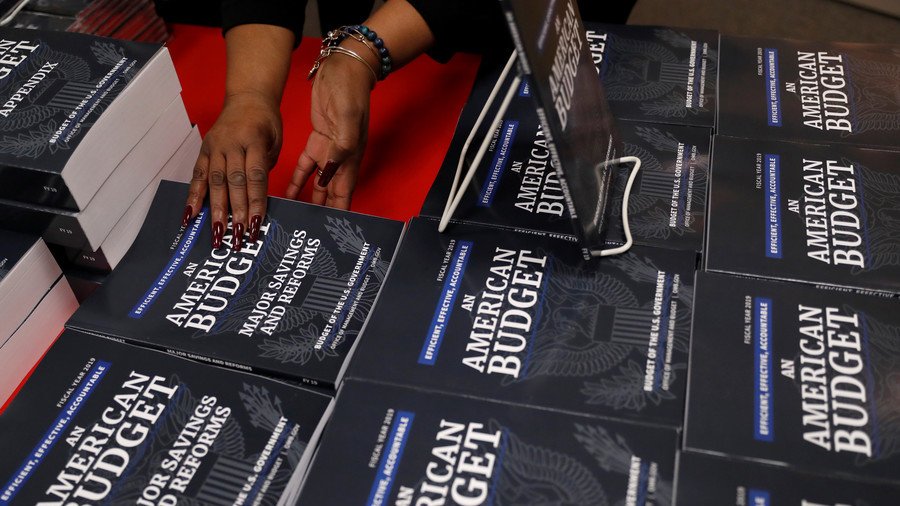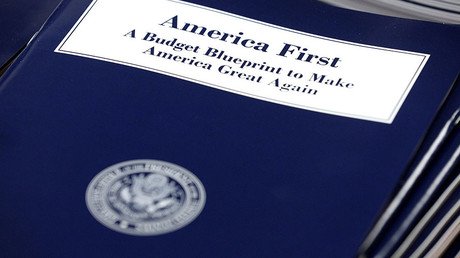Pleasing the Pentagon & building the wall: What’s in Trump’s 2019 budget?

The White House 2019 budget proposal offers the Pentagon and the president’s immigration agenda a generous boost. It also looks to modernize US infrastructure and the nuclear arsenal and seeks corporate partners to explore space.
Titled “An American Budget,” the proposal unveiled Monday lists a total of $4.338 trillion in government outlays in the fiscal year 2019. It also projects annual outlays for the next decade, ending at $7 trillion in 2028.
The Office of Management and Budget (OMB) said the proposal reflects the Trump administration’s commitment to the “safety, prosperity, and security of the American people,” and seeks to focus the government on “what matters most – protecting the Nation.”
The Pentagon
Unveiling the proposal on Monday morning, President Donald Trump said the Pentagon was pleasantly surprised, with Defense Secretary James Mattis telling him “we got everything we wanted.”
Trump said he wants Mattis to get better deals on military equipment, such as “twice as many planes for half the price.” The Pentagon is heavily invested in the F-35 Joint Strike Fighter program, estimated to cost $1.4 trillion over its lifetime.
The 2019 budget proposal envisions $617 billion baseline Pentagon funding, with another $60 billion for overseas contingency operations, better known as the warfighting slush fund. Additional military spending, including nuclear programs run by the Department of Energy, would bring the total request to $716 billion.
Part of the request is $24 billion to modernize the so-called “nuclear triad,” the land, sea and air-based strategic arsenal. It would also provide for 10 new navy ships, including three destroyers and two Virginia-class attack submarines.
While requesting funds for 77 new F-35s, mostly for the US Air Force, the budget also wants funding for 24 new F/A-18 Super Hornets and modernization of the existing F-16 fighter jets.
The wall, ICE and Border Patrol
Within the $18 billion request to fund the wall along the border with Mexico is the $1.6 billion for Customs and Border Patrol (CBP) enforcement efforts. Another $211 million would hire 750 additional Border Patrol agents, slowly moving towards Trump’s goal of eventually hiring 5,000.
Hiring and maintaining 2,000 new Immigration and Customs Enforcement (ICE) agents would cost $571 million, and “directly supports the president’s order for ICE to arrest all illegal aliens it encounters,” the document says.
Another $253 million would be spent on the CBP's National Targeting Center (NTC) and biometric programs, aimed at vetting visitors and immigrants before they arrive in the US.
Over $2.5 billion would be dedicated to fund the construction and maintenance of detention facilities for illegal immigrants across the US. Another $80 million would pay for 75 new immigration judge teams and 338 new prosecuting attorneys at ICE, so they can deal with the backlog of 650,000 cases currently pending in the immigration courts.
Infrastructure
As the first step towards an ambitions $1.5 trillion infrastructure package, the budget requests $200 billion for direct federal funding and incentives to state and local governments that would attract private investment.
Half of the amount would go to incentive grants, while $50 billion would go to rural projects, including broadband internet construction. The rest would be spent on existing programs and “transformative projects.”
Tucked away in this section is the provision for “Real Property Reforms” that would allow the government to sell off “unneeded Federal facilities” for private use, “potentially spurring local economic development.”
Opioids
A combined $13 billion in new funding over the next two years would be dedicated to battling the opioid epidemic. An estimated 64,000 Americans died of overdoses in 2016, the most recent year for which statistics are available. About a quarter of the $30 billion in drug control funding for 2019 would go to the opioid crisis in some way, according to estimates by the Office of National Drug Control Policy.
Diplomacy
The Department of State and the US Agency for International Development (USAID) are expected to “advance the national security interests of the United States by building a more democratic, secure, and prosperous world,” but they will have to do so on a base budget of $25.8 billion, 26 percent less than was enacted in 2017. The Department of the Treasury international programs would be funded to the tune of $1.4 billion, which is a $354 million or 20 percent reduction from the 2017 levels.
However, the proposal requests $12 billion for overseas contingency operations in places like Syria, Iraq, and Afghanistan, making it an almost $200 million increase over the 2018 budget.
Space
NASA is getting a mixed bag, with the $19.6 billion budget slightly over what it received in 2018, but $61 million less than in 2017. The budget proposes to end direct US government funding for the International Space Station (ISS) by 2025 and “provides $150 million to begin a program that would encourage commercial development of capabilities that NASA can use in its place.”
What’s next?
Monday’s document is little more than an advisory to Congress, a road map of how the Trump administration wants to spend money collected from US taxpayers. The compromise approved last week in the House and the Senate to avoid monthly shutdown threats has already allocated $57 billion more to domestic spending programs, for example. Likewise, last year Congress approved a larger sum for the Pentagon than the OBM requested, though some lawmakers and senior DOD officials found even that sum lacking.
One interesting takeaway is that the 2019 budget spoke of “multi-generational” reform of the US federal government that will take time but result in a bureaucracy that can adapt to changing needs over time.
Think your friends would be interested? Share this story!

















